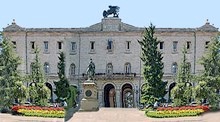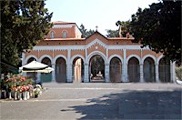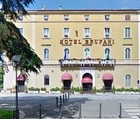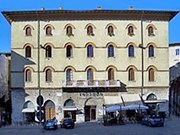Alessandro Arienti was born in Milan. He studied engineering and architecture at the Accademia di Brera there. Reginaldo Ansidei, the mayor of Perugia, appointed him as the chief engineer of Perugia in 1865 and he held this post until his death.
Alessandro Arienti played a major role in the urban planning of the city, which was particularly important after the demolition of Rocca Paolina: he prepared the plan for the entire area over the period 1866-83. The piazza that was named in honour of King Vittorio Emanuele II in 1861 (now Piazza d’ Italia, see Walk VII) was at the heart of these plans, which were given formal approval in 1867.
Palazzo del Governo (1869-72)

As noted above, the new Palazzo del Governo (now the Palazzo della Provincia e Prefettura), which stood over what had been the central part of Rocca Paolina, was at the heart of the urban redevelopment of Perugia after the unification of Italy. A competition was held in 1863 in order to select its design. Local submissions included a joint proposal by Nazareno Biscarini and Americo Calderini that was well-received. However, the design submitted by the “outsider” Alessandro Arienti was approved in 1867. (Nazareno Biscarini and Americo Calderini published a critical report on this decision, but to no avail).
The palace is built on a rectangular plan that coincided with what had been the central part of Rocca Paolina. Its most distinctive feature is the loggia that runs around all four sides.
Restoration of Palazzo dei Priori (1870)
Alessandro Arienti directed this project.
Extension of Civic Cemetery (1874-86)

Bishop Gioacchino Pecci (the future Pope Leo XIII) inaugurated the new Cimitero Civico (cemetery) in 1849. Alessandro Arienti supervised its extension in the period 1874-86: its elegant portal and the galleries along the two longer sides belong to this period. (Alessandro Arienti was to be buried here 22 years later).
Brufani Hotel (1882-3)

Teatro Turreno (1891)

Teatro Turreno in Piazza Danti was built on what had been orchards belonging to the Oddi family and was later used as the grain market. The Commune designated the area for use as a theatre, and Ulisse Rocchi, the mayor of Perugia, commissioned the design from Alessandro Arienti.
The palace is built on a base formed by a series of medieval buildings. There is a relief of a hand holding a sheaf of corn at each corner records the earlier use of the site. The structure was built largely of iron and other fire-proof materials. The discovery of a number of wells under the building led to difficulties in construction.
The theatre was restored in 1926 and again in 1954, after which it could hold an audience of some 2,000 people. Following these interventions, little of the original structure survives.
The ground floor of the theatre was used for other commercial purposes. Caffè Turreno to the right is a long-standing feature of the piazza. An Etruscan well can be be viewed through a glass panel in the floor.
Sadly, both Teatro Turreno and Caffè Turreno have recently closed.



